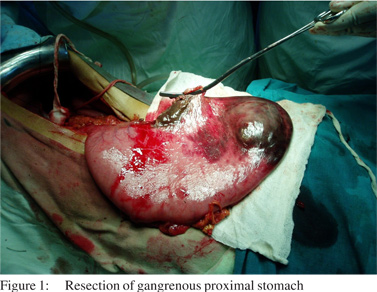48uep6bbphidvals|379
48uep6bbph|2000F98CTab_Articles|Fulltext
Introduction
Acute dilatation of stomach leading to perforation and gangrene is a very rare condition. First described in 1833 by S E Duplay,[1] acute gastric dilatation has been documented in a range of conditions of which the gastric volvulus is the commonest. The clinical presentation tends to be as acute abdomen with features of abdominal pain accompanied by copious vomiting in greater than 90% of cases. Abdominal distension is a pathognomonic sign of acute gastric dilatation.[2]
Case Report
A 64 year old male presented with upper abdominal pain of 4 days duration, initially colicky later continuous and generalized. He had persistent vomiting and obstipation of 2 days duration.There was no history of fever, trauma, haematemesis / melaena or similar episodes in the past. There were no known comorbidities. On examination he bore an anxious look and was afebrile with tachycardia. He was tachypnoeic, hypotensive with pallor and dehydration. Abdomen was grossly distended and tender with guarding and rigidity. Bowel sounds were absent and there was no free fluid. Rectal examination revealed a boggy swelling anteriorly. Systemic examination was not contributory. Lab parameters revealed a leukocytosis of 13,200/cu. mm. Other metabolic and biochemical parameters were within normal limits. Plain X-ray abdomen revealed a grossly dilated stomach with free air under the diaphragm.
A clinical diagnosis of a hollow viscous perforation was made and an emergency exploratory laparotomy carried out. Operative findings revealed a grossly dilated stomach with gangrenous proximal stomach. There was no gastric volvulus. The rest of the bowel was unremarkable. He underwent a stapled resection of the proximal stomach (Figure 1) with restoration of the bowel continuity by anastomosing the distal stomach with the oesophagus (Figure 2) and a feeding jejunostomy. He had an uneventful post-operative recovery with initial nutrition through the feeding jejunostomy for a week and subsequently started on oral feeds. He was discharged after three weeks. Histopathology revealed ischaemic gastropathy with no evidence of neoplastic pathology.


Discussion
Gastric necrosis and perforation are extremely uncommon because of a rich blood supply but when present can produce profound circulatory disturbance and death, particularly in the post operative period.[3] It is akin to paralytic ileus.
Various aetiologies leading to acute gastric dilatation which have been described include :Gastric outlet obstruction,retroperitoneal tumor involving duodenum,gastric volvulus, post abdominal surgery,trauma,diabetic ketoacidosis,anorexia nervosa,cerebral palsy / muscle dystrophy,diaphragmatic herniation,and psychogenic polyphagia Some rarer causes include post variceal sclerotherapy,following percutaneous endoscopic gastrostomy, laparoscopic gastric banding and dissection of greater curvature.[4,5] Acute dilatation has been described in Prader-Willi syndrome possibly related to genetic abnormalities of gastric homeostsis.These patients are able to consume large quantities of food without vomiting.[6]
The clinical features of acute dilatation include epigastric fullness, tachycardia, abdominal hyper-resonance, nausea and vomiting (described as ‘storm water of a peat laden stream’) and succussion splash.
Several mechanisms have been postulated to explain the occurrence of acute gastric dilatation. In 1842, Von Rokitansky described superior mesenteric artery syndrome as a cause.[1,7,8] In 1859, Brinton proposed the atony theory, where the primary abnormality is loss of gastric tone secondary to reflex inhibitionof gastric motor nerves causing relaxation of the upper oesophageal sphincter and subsequent aerophagia and gastric dilatation. Proximal gastrointestinal tract atony has also been attributed to electrolyte abnormalities such as hypokalemia and hypochloraemia.[1,7] Literature states that acute gastric dilatation in anorexic patients is caused by the development of a direct neurogenic paralysis secondary to malnutrition.[2]
The sequence of events that takes place after acute gastric dilatation include increasing intra-gastric pressure leading to gastric wall ischemia and perforation as well as pressure on the inferior venacava causing reduced venous return and hypotension. Early gastric dilatation can be managed conservatively with nasogastric aspiration, fluid resuscitation and correction of dyselectrolytemia. An upper GI endoscopy can be helpful and can decompress an acutely dilated stomach. A CT scan can pick up a retroperitoneal mass. Patients with neurological disorders will require a feeding jejunostomy. In advanced cases surgery remains the only option with resection of the necrosed segment and reconstruction by anastomosing the esophageal end to the remaining stomach or the jejunum. Even in cases where early surgery is undertaken there is a reported mortality of 50-60%.[2]
References
1. Todd SR, Marshall GT, Tyroch AH. Acute gastric dilatation revisited. Am Surg. 2000;66:709–10.
2. Adbu RA, Garritano D, Culver O. Acute gastric necrosis in Anorexia Nervosa and Bulimia. Arch Surg. 1987;122:830–2.
3. Turan M, Sen M, Canbay E, Karadayi K, Yildiz E. Gastric necrosis and perforation caused by acute gastric dilatation: report of a case. Surg Today. 2003;33:302–4.
4. Bortul M, Scaramucci M, Tonello C, Spivach A, Liguori G. Gastric wall necrosis from organoaxial volvulus as a late complication of laparoscopic gastric banding. Obes Surg. 2004;14:285–7.
5. Michel LA, Buche M, de Canniere L, Chenu P. Gastric volvulusafter coronary bypass. Lancet. 1997;349:251.
6. Wharton RH, Wang T, Graeme-Cook F, Briggs S, Cole RE. Acute idiopathic gastric dilation with gastric necrosis in individuals with Prader-Willi syndrome. Am J Med Genet. 1997;73:437–41.
7. Chaun H. Massive gastric dilatation of uncertain etiology. CMAJ. 1969;100:346–8.
8. Byrne JJ, Cahill JM. Acute gastric dilatation. Am J Surg. 1961;101:301–9.